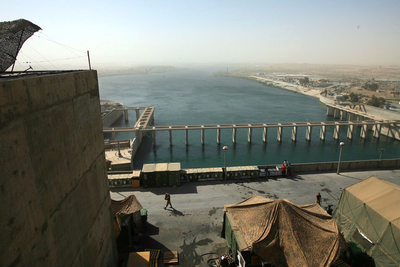The Acute Danger of Iraqi Dams
It's been apparent at least since the American-led invasion of Iraq in 2003 that the Mosul Dam, Iraq's largest, could spell devastation for Iraq due to a combination of faulty construction, governmental indifference, and an ongoing civil insurrrection. Were it to collapse, it would lead to the largest human-induced loss of life in history. (For more on this problem, see my coverage hereand here.)
The conquests in 2014 by what used to be known as the Islamic State in Iraq and Syria (ISIS) and now just as the Islamic State, have dramatically shown that other dams in Iraq can also pose problems, if not on so catastrophic a scale.
First, when ISIS seized Falluja in January 2014, it also took control of the Falluja Dam (or Barrage), which is on the Euphrates River, and proceeded to manipulate it for its purposes. Hamza Mustafa ofAsharq Al-Awsat quoted a pro-government militia leader a few months later, after Baghdad government forces managed to recapture the barrage, explained ISIS' tactics: ISIS
realized after closing the dam gates—which resulted in a rise in water levels behind the dam—that if the closure continued, they will be besieged twice, once by the armed forces, and the second by rising water, and if they had to withdraw, they would drown, which in turn forced them to reopen the floodgates.
The militia leader also explained the motives behind these maneuvers:
ISIS has two objectives: on the one hand, they want to drown the areas surrounding Fallujah, but the sudden attack by the [government] army foiled that plan; on the other hand, they want to cut off water supply to the central and southern governorates in order to give their war a sectarian dimension.
 The Falluja Dam (or Barrage). |
Second, ISIS approached the Haditha Dam, Iraq's second-largest, in late June, raising here too the possibility of catastrophic flooding. Reports the New York Times:
The ISIS militants advancing on the Euphrates River dam, about 120 miles northwest of Baghdad, were coming from the north, the northeast and the northwest. The fighters had already reached Burwana, on the eastern side of Haditha, and government forces were fighting to halt their advance, security officials said. … "This will lead to the flooding of the town and villages and will harm you also," the employee said he told the officers. According to the employee, who asked not to be named because he was not authorized to speak to the news media, the officer replied, "Yes, I know, it will be against us and our enemies."
 Haditha Dam in 2006. |
Comments:
(1) Mesopotamia, one of the most ancient areas of human civilization, has always been defined by its two great rivers, the Euphrates and the Tigris; how ironic that these life-giving sources could potentially also be the vehicle of the country's doom.
(2) The combatants in Iraq's growing civil war need to be compelled by their patrons (Turkey and Qatar, especially in the case of the Islamic State jihadis, Iran in the case of the Baghdad government) to agree on some basic terms of combat, such as not using waterworks as weapons of war. This is where outside powers (the West, Russia, China) can be of help. (July 1, 2014)